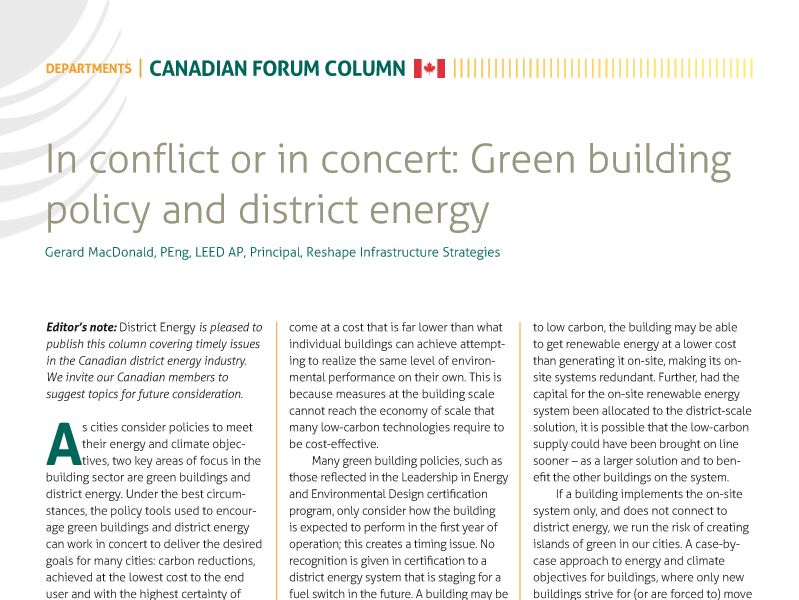 As cities strive to achieve low carbon outcomes for buildings, one of the major tools at their disposal is a green building policy, such as requiring certification with LEED or other standards. In dense areas, with the right development patterns, cities may also have the opportunity to develop or facilitate district energy, which provides a platform to serve multiple buildings with low-cost renewable energy. In some cases, green building policy tools and district energy are in alignment. In other cases, they are in conflict. Understanding the key issues is critical to getting the outcomes we want. For most policymakers, those outcomes are lower carbon emissions and more resilient energy systems, at the lowest cost to the end user, with the highest certainty of outcome.
As cities strive to achieve low carbon outcomes for buildings, one of the major tools at their disposal is a green building policy, such as requiring certification with LEED or other standards. In dense areas, with the right development patterns, cities may also have the opportunity to develop or facilitate district energy, which provides a platform to serve multiple buildings with low-cost renewable energy. In some cases, green building policy tools and district energy are in alignment. In other cases, they are in conflict. Understanding the key issues is critical to getting the outcomes we want. For most policymakers, those outcomes are lower carbon emissions and more resilient energy systems, at the lowest cost to the end user, with the highest certainty of outcome.
It’s a complicated topic – more so with the many voices speaking different languages. The green building industry does not always look at problems on the same scale or control boundary as a stakeholder from the district energy industry, and vice versa. They don’t use the same metrics or use the same terminology. Policy makers are in the middle, and understandably can get lost with all the jargon. We think distilling the problem down to four main issues, then doing a deeper dive within each, helps structure the conversation around the conflicts between district energy and green building policies.
I presented this structure on a panel at the 2015 International District Energy Association (IDEA) conference in Vancouver, and subsequently published an article in the Canadian Forum Column for the 2016 Q2 edition of the IDEA magazine. Some of these issues also extend beyond green building policies, to building codes and standards. The four main issues are:
- Timing
- Boundaries
- Metrics
- Demand Reduction vs Greening Supply
The full details are in the article, but suffice to say that right now, green building policy is often designed to look only at the scale of the building, with a bias against off-site energy solutions. For dense areas where district energy can work, this is a real hurdle. And for areas where the municipality is actively promoting or developing district energy, it can create major confusion and conflict.
There is the potential for not just resolution of the conflicts, but actual promotion of district energy systems via green building policy. But, we need to walk before we run. Before we start to talk about how green building policy tools can incent neighbourhood scale networks (where these networks make sense) we need to resolve how to put district energy systems on equal footing with on-site systems. Currently, there are many examples where green building policy is actually creating barriers to neighbourhood scale systems getting built and growing. There is an opportunity cost of not accessing the lowest cost, low carbon solutions in cities.
We hope this structure to discuss and consider the issues helps with the conversations. Stay tuned in this space for more discussion on this evolving topic.
Gerard MacDonald